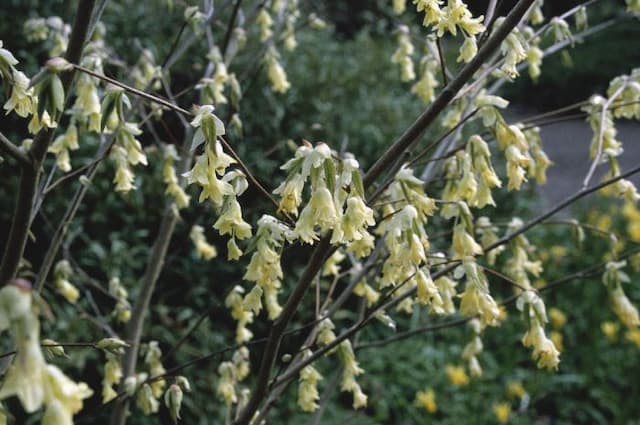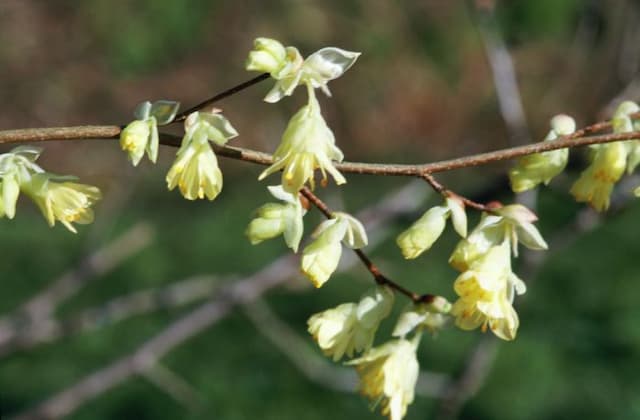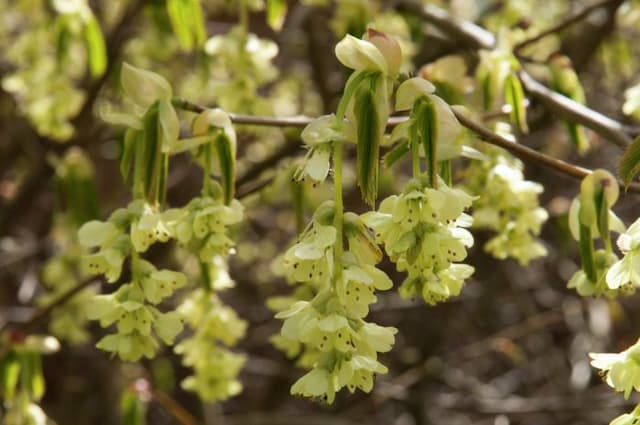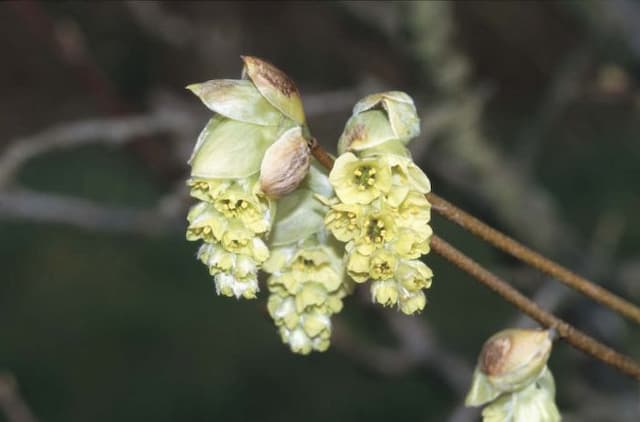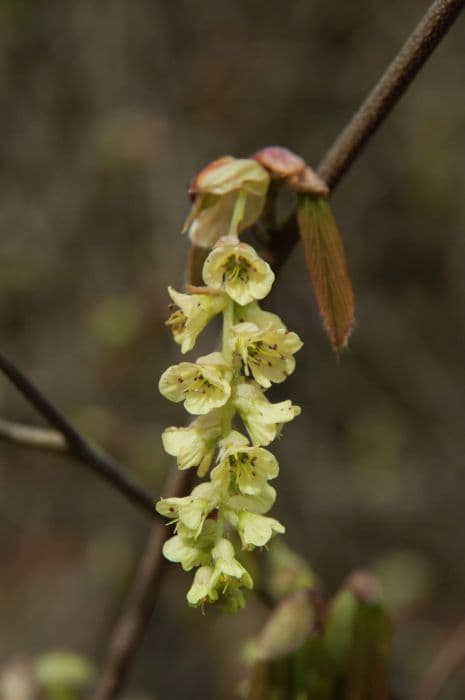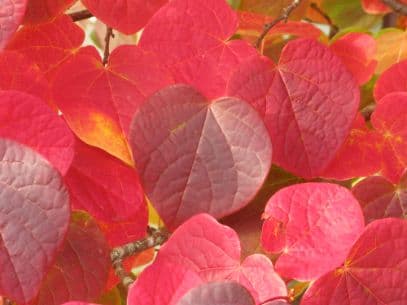Witch Hazel Hamamelis × intermedia 'Ruby Glow'

ABOUT
The plant commonly known as 'Ruby Glow' Witch Hazel is a captivating ornamental plant that is particularly noted for its striking flowers and foliage. This variety of Witch Hazel is named for its deep, ruby-red flowers which bloom in the late winter to early spring. The flowers are quite unique, featuring ribbon-like petals that burst forth in clusters, providing vibrant color during a time when few other plants are in bloom. These blossoms not only add a splash of warmth to the garden in cooler months, but they are often richly fragrant, emitting a spiced, citrus-like scent that can be quite delightful. The leaves of 'Ruby Glow' Witch Hazel are also noteworthy, emerging in spring in shades of green and, as the growing season progresses, they often turn to attractive shades of yellow, orange, or red in the fall, providing a prolonged season of interest. The foliage is broadly oval in shape and grows in an attractive, slightly wavy pattern along the stems. The overall form of the 'Ruby Glow' Witch Hazel is typically vase-shaped, with a rounded canopy and an open, spreading habit, giving it a graceful appearance in the landscape. The branches are somewhat irregular, adding to the plant's natural charm. This bushy plant appropriately complements a variety of landscape settings and provides color and interest during seasons when other plants may be dormant.
About this plant
 Names
NamesFamily
Hamamelidaceae
Synonyms
Witch Hazel, Winterbloom, Ruby Glow Witch Hazel
Common names
Hamamelis × intermedia 'Ruby Glow'.
 Toxicity
ToxicityTo humans
Witch hazel, which includes the cultivar Hamamelis × intermedia 'Ruby Glow', is generally considered non-toxic to humans. There is no widespread documentation of toxicity or poisonous effects from ingesting parts of this plant. Accidental ingestion of small quantities is unlikely to cause any adverse effects. However, as with many plants, it is possible that some individuals could experience an allergic reaction or gastrointestinal upset if they consume parts of the plant in significant quantities.
To pets
Witch hazel, which includes the cultivar Hamamelis × intermedia 'Ruby Glow', is not commonly known to be toxic to pets. Like humans, pets are unlikely to suffer serious health consequences from ingesting small amounts of the plant. That being said, pets, much like people, might experience mild digestive upset if they consume parts of the witch hazel plant in larger quantities. If any symptoms do appear, or if a pet has consumed a large amount of the plant, it is advisable to consult a veterinarian.
 Characteristics
CharacteristicsLife cycle
Perennials
Foliage type
Deciduous
Color of leaves
Green
Flower color
Red
Height
12 feet (3.66 meters)
Spread
10 feet (3.04 meters)
Plant type
Shrub
Hardiness zones
5
Native area
Asia
Benefits
 General Benefits
General Benefits- Winter Interest: This hybrid witch hazel blooms in late winter, adding color to the garden during the dreariest months.
- Fragrant Flowers: 'Ruby Glow' produces reddish to copper flowers with a distinct fragrance that can be enjoyed on winter days.
- Attracts Pollinators: Despite its winter bloom time, the flowers provide a rare nectar source for early-emerging pollinators.
- Seasonal Foliage: The plant offers attractive green foliage in spring and summer, which transitions to vibrant fall colors before leaf drop.
- Low Maintenance: Once established, it requires minimal care, making it suitable for low-maintenance landscapes.
- Drought Tolerance: It can withstand periods of dryness once it is well-rooted, adding to its hardiness in various climates.
- Architectural Interest: With its v-shaped branching pattern, it adds structural interest to gardens even when not in bloom.
- Urban Hardy: This plant adapts well to urban environments, dealing with pollution and constrained soil conditions effectively.
 Medical Properties
Medical PropertiesThis plant is not used for medical purposes.
 Air-purifying Qualities
Air-purifying QualitiesThis plant is not specifically known for air purifying qualities.
 Other Uses
Other Uses- Witch hazel can be used as a natural indicator of the changing seasons with its blossoms typically appearing in late winter to early spring.
- In landscaping, 'Ruby Glow' serves as an attractive specimen plant around which garden designs can be themed, especially given its vibrant red to purple flowers.
- This plant may act as a shelter for small wildlife during the harsher months, with its dense branches providing cover.
- The branches of witch hazel can be incorporated into floral arrangements for a rustic and unique touch.
- Its colorful foliage and flowers can serve as an educational tool for botany and horticulture studies, especially for winter interest plants.
- Witch hazel twigs have historically been used as divining rods for water dowsing, although this practice is considered a pseudoscience.
- The plant can be used in photography and painting as a subject for capturing the beauty of winter-blooming species.
- In craft activities, children and adults alike may use the plant's leaves and flowers to create pressed flower art and other botanical crafts.
- Due to its slow growth and manageable size, witch hazel is an ideal candidate for a bonsai project.
- Witch hazel can play a role in cultural festivals that celebrate spring, with its early blossoms symbolizing the end of winter.
Interesting Facts
 Feng Shui
Feng ShuiWitch Hazel is not used in Feng Shui practice.
 Zodiac Sign Compitability
Zodiac Sign CompitabilityWitch Hazel is not used in astrology practice.
 Plant Symbolism
Plant Symbolism- Fascination: The witch hazel, which Hamamelis × intermedia 'Ruby Glow' is part of, captivates observers with its vibrant, fringe-like flowers that bloom in winter when most plants are dormant.
- Healing and Comfort: Historically, witch hazel has been used for its medicinal properties, symbolizing healing. It is known for its astringent qualities and skin-soothing effects.
- Protection: With its sturdy nature and the ability to thrive in winter, witch hazel represents a symbol of protection against adverse conditions.
- Unique Beauty: The ‘Ruby Glow’ variety, with its distinctive reddish flowers, symbolizes unique beauty and stands out in the winter landscape, suggesting the uniqueness in each individual.
- New Beginnings: Blooming in the cold winter months, witch hazel represents hope and the promise of new beginnings as it heralds the eventual arrival of spring.
 Water
WaterThe Witch Hazel 'Ruby Glow' should be watered deeply to encourage root development, which translates to about 1 to 1.5 gallons for a young plant, making sure the water penetrates the soil well without causing standing water. During the growing season, water the plant once a week unless there has been a significant amount of rain. In the absence of rain or during particularly dry periods, increase watering frequency to twice per week. Adjust watering during winter months and for mature plants, as they will require less frequent watering given their established root systems, typically needing water once every two to three weeks if there has been no rainfall.
 Light
LightWitch Hazel 'Ruby Glow' thrives in full sun to partial shade. The ideal spot for planting is one where it can receive at least four to six hours of direct sunlight per day, but it is also tolerant of light dappled shade. Avoid deep shade conditions as this can result in fewer flowers and a less vigorous plant.
 Temperature
TemperatureWitch Hazel 'Ruby Glow' can survive in a range of temperatures from winter lows of 0 to 10 degrees Fahrenheit to summer highs up to 90 degrees Fahrenheit. However, the ideal temperature range for the plant is between 30 and 75 degrees Fahrenheit to promote optimal growth and flowering. It’s important to protect the plant from extreme cold by offering mulch or wind protection, especially when it's young.
 Pruning
PruningPruning Witch Hazel 'Ruby Glow' is primarily done for shaping and removing any damaged or crossed branches to maintain plant health and aesthetics. The best time to prune is in the spring after the flowers have faded. Pruning once a year is generally sufficient for keeping the plant in good shape, ensuring you make clean cuts to prevent disease.
 Cleaning
CleaningAs needed
 Soil
SoilWitch Hazel 'Ruby Glow' requires well-draining soil rich in organic matter with a pH of 5.5 to 6.5. For optimal growth, mix garden soil with compost and peat moss to improve fertility and drainage. Mulching around the plant can help maintain soil moisture levels and suppress weeds.
 Repotting
RepottingWitch Hazel 'Ruby Glow' is typically planted in the ground and seldom needs repotting. As a larger shrub, it is not commonly grown in containers that would necessitate frequent repotting.
 Humidity & Misting
Humidity & MistingWitch Hazel 'Ruby Glow' tolerates a wide range of humidity levels but prefers average to high humidity. It does not require any special humidity adjustments when grown outdoors.
 Suitable locations
Suitable locationsIndoor
Limited space can inhibit 'Ruby Glow' Witch Hazel's growth.
Outdoor
Plant in sun or part-shade with moist, well-drained soil.
Hardiness zone
5-9 USDA
 Life cycle
Life cycleHamamelis × intermedia 'Ruby Glow', commonly known as Witch Hazel 'Ruby Glow', begins its life when a seed, often produced through cross-pollination facilitated by insects, germinates in the soil during spring. The seedling then establishes itself, growing roots and shoots to mature into a small shrub. As it matures, which can take several years, it develops distinctive, broad leaves and a branching structure. Every winter, typically before the leaves emerge, 'Ruby Glow' blooms with fragrant, red to coppery-red flowers that are a notable characteristic of this cultivar. After pollination, the flowers develop into seed capsules which ripen in the fall and are ejected from the plant to begin the next generation. Throughout its life, which can span several decades, 'Ruby Glow' will experience cycles of growth, flowering, and dormancy, typically with slow to moderate growth rate and minimal maintenance requirements.
 Propogation
PropogationPropogation time
Late winter to early spring
Witch hazel 'Ruby Glow' can be propagated most effectively by semi-hardwood cuttings. This is usually done in late summer after the current year’s growth has started to harden. A cutting should be about 4 to 6 inches (10 to 15 centimeters) long and taken from a healthy branch. The lower leaves are removed, and the cut end dipped in rooting hormone to encourage root development. The cutting is then placed in a well-draining potting mix, ensuring the remaining leaves do not touch the soil to prevent rot. The pot should be kept in a warm, humid environment with indirect light, and the soil must remain moist but not waterlogged. Roots typically develop within 4 to 8 weeks, after which the cutting can be gradually acclimated to normal conditions before being transplanted into the garden.
